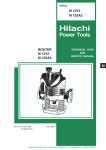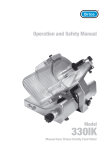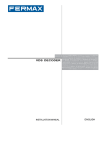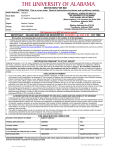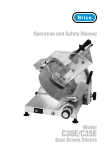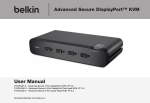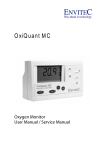Download user manual
Transcript
Operation and Safety Manual Model EXPERT Vegetable Processor SAFETY ISSUES 1. DO NOT touch this machine without proper training in its use and authorisation from your supervisor. 2. Never attempt to operate this machine without proper training in its use and authorisation from your supervisor. 3. The machine must be firmly located on a solid, level bench/table, and have adequate clearance to either side of the machine. 4. Guards must be in place before plugging in and turning on the machine. 5. Always use the three-pronged plug provided. 6. Never place your hand in the machine’s feeder chute. 7. NEVER attempt to place your hand into the output area of the machine. 8. Keep hands, arms, hair and loose clothing clear of all moving parts. 9. ALWAYS wear appropriate protective clothing when cleaning or replacing the cutting or blade group. We strongly recommend the use of steel mesh gloves for such tasks. 10. Should the machine jam, SWITCH off and unplug before removing the obstruction. 11. SWITCH off and unplug the machine from its power source before cleaning, sanitizing or servicing. 12. Use only the attachments provided by the manufacturer and designed for this machine. YOUR SAFETY IS OUR PRIMARY CONCERN DECL AR ATI ON OF C ONFO RMITY Food Processor Machine Model: Serial Number: Dated: is built in conformity with the provisions of: 9 8/ 37 /C EE Machinery Directive E N 2 94 Safety of machinery - Safety distances to prevent danger zonesbeing reached by the upper limbs. EN 60204 Electrical equipment of industrial machines: Part 1 - General Design 89/109/CEE Directive for the materials and things destined to come into contact with food. 89/336/CEE Directive on Electromagnetic Compatibility (EMC) 73/23/EEC Directive on low voltage. Operation and Safety Manual Introduction ™ Overview This Operation and Safety Manual has been prepared to introduce you to the Brice Expert range of Vegetable Processors. It explains the operation, cleaning and maintenance of the machine in simple, clear terms and with an emphasis on your safety. Throughout the Manual procedures are supported by photographs showing the parts involved and the recommended safe method of handling those parts. A word to the wise This Manual is really two sets of instructions in one - some sections are relevant to all Brice food processing machines, while other sections only concern a particular machine or range of machines. Make sure that you read this Manual carefully so that you are familiar with the features and procedures that are unique to the machine that came with it. How this Manual is arranged This Manual is made up of five sections: • • • • • Introduction - which explains the Manual itself, safety issues associated with using a Vegetable Processor, gives a brief introduction to the features and components of the Vegetable Processor and steps you through the installation of the machine; Operation - explains the use of the Vegetable Processor, including pre-operational checks; Cleaning - explains the procedures for keeping the Vegetable Processor clean; Maintenance - details those procedures that you can perform to ensure the trouble-free operation of the Vegetable Processor; and Trouble shooting - details some malfunctions and how to fix them. Conventions and Symbols used in this Manual To reduce confusion, and to highlight important points and safety matters, we have established some standard terms and symbols: • • • EXPERT Vegetable Processor “Vegetable Processor” Whenever we talk about the Vegetable Processor, we mean the Vegetable Processor that is covered in this Manual. “foodstuff” We use the word “foodstuff” to refer to any kind of food that is usually chopped using the Vegetable Processor. “inlet chute” or “input feeder” We use these terms to refer to the opening in the top of the machine in which foodstuff should be placed. Introduction 1.1 Operation and Safety Manual ™ • • • SAFETY WARNINGS The Special Note flag This is an upside-down triangle with an exclamation mark inside it. It appears in the left margin of the page, like this, whenever we want to draw your attention to an important point. The “No Hands” warning flag This is a circle with the outline of a hand and a black bar through the hand. It appears wherever we want to warn you that either: you shouldn’t put your hands in or near a particular component; or that you must wear steel mesh protective gloves to carry out a particular procedure. The “Power” warning flags There are two power warning flags. The first, a lightning bolt inside an upside-down triangle, is used whenever we want to remind and warn you that the Vegetable Processor is connected to the mains power supply. The second warning flag is a circle with the outline of a lighting bolt and a black bar through the bolt. It appears to remind you that a particular procedure must be carried out with the power to the Vegetable Processor turned off at the powerpoint and the Vegetable Processor’s power plug disconnected from the powerpoint. This is an electrical device that uses mains (single phase 240 Volt) power. It uses a high speed rotating blade that is extremely sharp. You must be careful in how you handle the Vegetable Processor at all times. The following special warnings must be complied with for your own safety and the safety of others. There are NO USER-SERVICEABLE electrical components in this FOOD PROCESSOR. All electrical components are electrically isolated to Earth and are sealed for your safety. You must not attempt to touch any electrical components or wires - you may expose yourself to the risk of serious injury by electrocution. Unless otherwise indicated, any cleaning or maintenance procedure must be performed with the power to the Vegetable Processor switched off and the Vegetable Processor’s power cord disconnected from the powerpoint. Failure to turn off and disconnect power may result in serious injury caused by the Vegetable Processor being accidently turned on during cleaning or maintenance. Vegetable Processor blades are extremely sharp and can cut through fingers and hands just as easily as products to be sliced. Whenever you carry out any procedure that places your hands on or near the Vegetable Processor blades you must wear suitable protective hand coverings such as steel mesh gloves to prevent accidental injury. 1.2 Introduction EXPERT Vegetable Processor Operation and Safety Manual The Brice Model EXPERT Vegetable Processor ™ The Expert Vegetable Processor has been designed for high volume use in larger restaurants, supermarkets and delicatessens. Convenience features include, fast blade change and dual inlet chutes which make for fast and efficient slicing of any kind of fruit or vegetable in the busiest environment. • • • • • manufactured in stainless steel and anodised aluminium to resist oxidisation and corrosion; constructed for easy cleaning; forced ventilation to motor to prevent overheating; all bearings are self-lubricating and sealed-for-life; safety cutout switches for basin, cover and inlet chute. Components of the Vegetable Processor The following picture illustrates the main components of the Vegetable Processor. 5 4 2 3 1 6 Installing the Machine 1 2 3 4 5 6 7 ON/OFF buttons cover release knob inlet feeder feeder handle feeder plunger outlet chute overheat reset button 7 Positioning the Vegetable Processor The Vegetable Processor must be mounted on a flat, stable surface that is strong enough to hold the weight of the machine. It is important to ensure that the machine can be both easily loaded and operated, and we recommend a bench or table height of 800mm to achieve this. No matter where you put the Vegetable Processor, you must allow at least as much space as the overall dimensions indicate. Allowing an additional minimum of 30cm either side of the Vegetable Processor will make access for cleaning and maintenance easier. The Vegetable Processor ejects the processed food through the large chute at the front of the machine. Ensure that there is enough space on the bench or table top to allow a collection container to sit underneath the chute. Alternatively, and if space is tight, the Vegetable Processor may be positioned with the ejection chute out over the edge of the bench or table and a container placed in front of the bench and below the chute. This option is not recommended as there is considerable potential for creating an unsafe and unhygienic mess. EXPERT Vegetable Processor Introduction 1.3 Operation and Safety Manual ™ A note about the electrical supply The EXPERT Vegetable Processor uses a single-phase 240V, 50Hz power supply - standard domestic power. Therefore, there shouldn’t be any issue with correct wiring of the power supply. However, the following check will determine if the power supply is correctly wired and that the Vegetable Processor is operating correctly: 1. 2. 3. 4. 5. 6. Ensure that only the ejector disc is fitted and secured. Connect the powerplug to the powerpoint and switch on. Close and latch the cover. Check that the feeder arm is down and that the feeder pressure plate is in the feeder hopper. Push the Start button Look up into the ejection chute and check that the ejector disc is turning anti-clockwise. Cleaning and function check Before you use the Vegetable Processor, we recommend that you wipe down all exposed surfaces with a soft cloth that has been placed in clean warm water and light detergent and squeezed dry. This will remove any traces of machine oil, dirt or grit picked up during manufacture or storage. Before you wipe down the machine, make sure that the power is turned off at the wall socket/powerpoint. Once the machine is clean you can check that it is functioning correctly. 1. Switch on power to the machine from the wall socket/powerpoint. 2. Make sure that the Vegetable Processor is turned off at the power switch on the side of the machine. 3. Open the Vegetable Processor cover by pulling the cover release lever (located on the right hand side of the cover) forward. 4. Raise the cover and place the supplied plastic ejector disk over the drive spindle - it may be keyed to the spindle on some models. There is no need to place a blade disk in the Vegetable Processor for this check. 5. Close and secure the cover by pressing the cover down onto the release lever until it clicks. 6. Remove the smaller plunger from the top of the feeder reducer and look down into the throat of the Vegetable Processor so that the plastic ejector disk is visible. DO NOT ATTEMPT TO DO THIS WHEN THERE IS A BLADE MOUNTED IN THE MACHINE. 7. Turn the Vegetable Processor on using the power switch on the side of the machine. Immediately the plastic ejector disk will spin in an anti-clockwise direction. 8. Turn the Vegetable Processor off at the power switch. The Expert Vegetable Processor is now ready to use. 1.4 Introduction EXPERT Vegetable Processor Operation and Safety Manual Operation ™ 5 4 2 3 1 6 1 2 3 4 5 6 7 ON/OFF buttons Cover release lever Inlet feeder Feeder handle Feeder plunger Outlet chute Overheat reset button 7 Things to keep in mind 1. Only use the large or small plunger supplied to push the vegetables into the Vegetable Processor. 2. The recommended, and only safe way of changing blades is with the power switched off at the powerpoint. 3.Apply a steady pressure to the plunger when using the Vegetable Processor. Sudden heavy pressure may cause a jam as the blade discs try to deal with too much foodstuff being forced into contact with the cutting surfaces. 4. DO NOT place frozen foodstuffs, or foodstuffs containing bones, in the Vegetable Processor. These will only damage the blades. Standard operation The Vegetable Processor with its cover open. The ejector disk is visible in the machine. 1. Pull the cover release lever (2) forward and open the cover. 2. Slide the plastic ejecting disc over the drive spindle, and then the chosen cutting disc or, for dicing, the chosen dicing disc, followed by the chosen cutting disc for the job. Use the Disc Selector Guide on the next page to help you decide which disc to use. 3. Close and secure the cover by pressing the cover down onto the release lever until it clicks. This will disengage the safety cutout and allow the machine to run. 4. Press the ON/OFF button momentarily to hook the disc into the correct position. 5. Raise the feeder reducer (4) on its guide post and swing it aside from the inlet feeder (3). Place the foodstuff inside the inlet feeder, swing the reducer back over feeder and lower it until it comes in contact with the foodstuff. For smaller foodstuffs, simply remove the small plunger from the feeder reducer, insert the foodstuff in the throat of the smaller inlet, and replace the plunger. 6. Turn the machine on using the ON/OFF button. 7. With your left hand lightly move the feeder plunger downwards until foodstuff is fully processed. You may continue to introduce more foodstuff by lifting the handle and placing foodstuff into the inlet chute. The machine will start automatically when the handle is closed. 8. Repeat step 7 as often as is required. 9. When cutting is completed, switch off the power at the ON/OFF button. The ON/OFF switches. EXPERT Vegetable Processor Operation 2.1 Operation and Safety Manual ™ Changing or fitting a new disc 1. Make sure that the machine is switched off. 2. Pull the cover release lever (2) forward and open the cover. 3. Turn the disc anti-clockwise and cover the cutting edge with appropriate material (rubber, fabric, etc.) then lift it by setting your hand under the disc. If no disc is fitted, go to Step 4. 4. Insert the plastic ejection disc and then the chosen disc or disc combination for the job. Use the Disc Selector Guide below to help you decide which disc to use. 5. Close the cover. Press the ON/OFF button to hook the disc into the correct position. Disc Fitting Guide Disc type Purpose/Usage E1, E2, E3, E4, E6, E8, E10 & E14 For slices from 1 to 14 mm. Potato chips, potato, turnip, cabbage, cucumber, carrot, mushroom, onion, marrow, aubergine, fennel, artichoke. E5, E1S & E2S For slices from 1 to 5 mm. Hard salami, mushroom, tomato, lemon, orange, apple, banana, pineapple, grapefruit, etc. E3o, E4o, E6o, E8o, E10o, & E14o For fruit and vegetable waved slices from 1 to 14 mm. Match-like Cutting Discs H2.5, H4, H6, H8 & H10 Celery, marrow, beetroot, carrot, potato, cabbage, etc Shredding Or Grating Discs Z2, Z3, Z4 & Z7 Carrot, celery, potato, apple, turnip, beetroot, red cabbage, cheese, chocolate, etc. V Cheese, dry bread, nuts, chocolate, etc Cubic Cutting Discs D8x8, D10x10, D12x12, D16x16 & D20x20 Chipping Grid Discs B6, B8 & B10 Used in combination with any of the E series discs produces three different sizes of cubes or strips for use in soups, fruit salads, etc. Use in combination with E series discs to obtain matchlike chips. Use with the Eo series discs to produce chips with waved sides. Slicing Discs 2.2 Operation EXPERT Vegetable Processor Operation and Safety Manual Cleaning the Machine ™ This section deals with cleaning your Vegetable Processor. We recommend that, before cleaning or maintenance tasks are undertaken, the machine operator(s) receive some training from authorised Brice representatives, preferably during the installation phase. Before carrying out cleaning or maintenance tasks, it is important that power to the Vegetable Processor is disconnected at the powerpoint. General Cleaning The Vegetable Processor has been designed and built for efficient and speedy cleaning to ensure hygienic operation. Before using the Vegetable Processor 1. Before the Vegetable Processor is switched on for the first time each day, quickly wipe over all exposed surfaces with a cloth that has been placed in warm water and squeezed dry. This removes any dust or other matter that may have been deposited over night. After each cutting job 1. Remove the discs, the grid for cutting dices and the plastic ejector disc and wash thoroughly in warm water and mild detergent. 2. Wipe down exposed portions of the machine and the area where the discs rest, with a cloth that has been placed in warm water and mild detergent and squeezed dry. Be sure to clean off any foodstuff that has adhered to the inside top of the machine cover and the output chute. At the end of the day 1. After the Vegetable Processor has been used for the last time, turn the machine off at the power switch and at the powerpoint, and disconnect the power cord. 2. Turn the cover securing knob anti-clockwise to open the cover, loosen the two cover release knobs at the back to remove the cover completely. Wash in warm water and a mild detergent. 3. Remove the discs, the grid for cutting dices and the plastic ejector disc and wash thoroughly in warm water and mild detergent. 4. With a cloth that has been placed in warm water and mild detergent and squeezed dry, wipe down all visible surfaces, including where the cutting discs rest. How frequently the Vegetable Processor is cleaned will depend on how heavily the machine is used. However, we recommend that you adopt the following cleaning schedule as a MINIMUM requirement to maintain hygiene. Before first use The cleaning schedule Wash down inlet chute, cover and discs Wipe down all exposed surfaces (no disassembly) Clean all surfaces including discs (disassemble machine) EXPERT Vegetable Processor After every use After last use • • • Cleaning 3.1 Operation and Safety Manual Maintenance & Troubleshooting ™ This section deals with routine maintenance and troubleshooting for your Vegetable Processor. Technical specifications for the Vegetable Processor are also included. We recommend that, before cleaning or maintenance tasks are undertaken, the machine operator(s) receive some training from authorised Brice representatives, preferably during the installation phase. Before carrying out cleaning or maintenance tasks, it is important that power to the Vegetable Processor is disconnected at the powerpoint. Routine Maintenance The robust design of the Vegetable Processor means that there is very little required in the way of routine maintenance. Generally, the only maintenance required is cleaning (discussed in the previous section). We recommend that you clean the machine prior to any other maintenance operation so that all surfaces are free of dirt and grease. This makes the machine easier and safer to handle. If the machine is to be idle for some time proceed as follows; 1. 2. 3. 4. Disconnect the plug from the power supply. Clean the machine as described in the previous section. Wipe over the machine elements with white Vaseline oil or a similar product. Cover the machine with a nylon (or similar) cloth. Troubleshooting Problem The machine does not start when the power is turned on. Probable cause Remedy Power turned off at powerpoint. Check that power plug is connected; check that power is switched on at powerpoint Cover is open. A safety switch prevents the machine starting if the cover is open. Check that the cover is closed and secured. Feeder arm not down A safety switch prevents the machine starting if the feeder arm is raised out of the feed hopper. Lower the feeder arm. Electrical connections are loose. Check the electrical circuit and tighten connectors if required. WARNING: This should only be performed by a qualified electrical contractor. The machine jams during operation Technical Specifications Frequency The motor just stopped 50Hz Voltage 240V Power output 600W Weight 25 kg Dimensions (LxWxH) 550x220x460 Temperature Range +5°C - +40°C dB <70 EXPERT Vegetable Processor The machine is noisy Too much pressure being used Reduce pressure on plunger Incompatible foodstuff being processed Remove foodstuff and clear blockage. WARNING: Any clearance of blockages should only be performed with the machine switched off at the powerpoint. Overheated after long use Wait 10 - 20 minutes for the motor to cool (the motor is fitted with a thermal cutout to prevent it being damaged if it gets too hot. Motor overloaded An overload reset switch is fitted to prevent mechanical stress to the motor. It is located on the right side of the machine. Open the Vegetable Processor cover and clear whatever food stuff is in the machine. Close the cover and press the reset switch. Disc, grid or ejector not fitted properly Open the cover, clear any foodstuff and refit the cutting or grating disc, grid or ejector, ensuring that all components engage properly. Drive belt needs tensioning Contact your authorised service representative. Maintenance 4.1 ™ Copyright Information Copyright © 2007 Brice Australia Pty. Ltd. This document may not be reproduced, in whole or in part, by any means without the prior express written permission of the copyright owner. Brice and the BRICE logotype are trademarks of Brice Australia Pty. Ltd. Printed in Australia 27024/EXPERT_man












